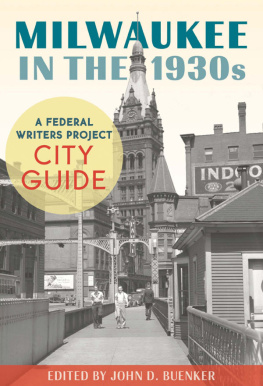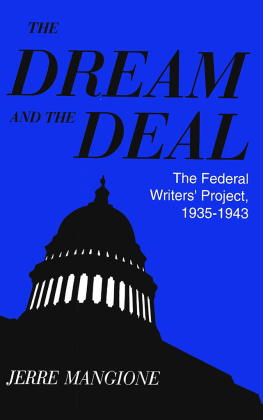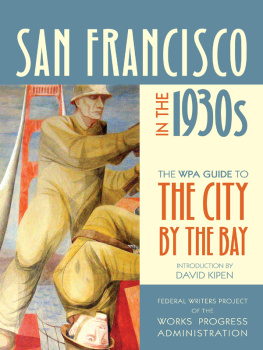THE OHIO GUIDE
The WPA Guide to
Ohio
The Buckeye State

Trinity University Press
San Antonio
Published in 2014 by Trinity University Press
San Antonio, Texas 78212
www.tupress.org
This book was first published as part of the Works Progress Administrations Federal Writers Project, a United States federal government project to fund written work and support writers during the Great Depression. It has been published in various editions, but this edition replicates the original. Trinity University Press is proud to make these books available through the WPA Guides to America Digital Library.
978-1-59534-233-1 ebook

T HIS book is the major contribution of the Writers Project in Ohio to the American Guide Series, which is unfolding a monumental picture of our Nation, past and present, never before revealed or undertaken. The task has been long and often difficult. Ohio is thickly populated, various, and cosmopolitan. It was settled rapidly by all classes and types of people from many States, and it grew in haste and in all directions at once. It has never unified itself with legends or traditions like certain of its neighbors. Ohioans have few marks to identify them as a group or to connect them with their geographical boundaries, excepting of course the way they pronounce the name of their State. The information about Ohio and its people is stupendous and at the same time inadequate and somewhat inaccessible because of its nature and its magnitude. One of the major tasks of the project has been to select, sort out, and check the usual data about the State, and to supplement them by consulting old newspapers, diaries, and documents, by talking with venerable citizens who know things not written in the histories, and by traveling the highways and by-roads through towns, villages, and farmlands, to report what Ohio is like at this moment and to tell the story of how it came to be. The Ohio Guide is the fruit of many months of this kind of labor by its staff of workers in all parts of the State.
The Guide has three main divisions. In the seventeen essays we have tried briefly to record and to interpret some of the more interesting and important developments in the political, industrial, and cultural life of Ohio, with emphasis upon those features peculiar to the State. Nineteen cities have been grouped in a separate section for individual treatment. The map of the State is dotted with cities and towns, for Ohioans have gathered themselves into and around urban centers. These cities and towns have marked individuality even in external appearance, and we have chosen them not for their size alone, but because they are representative of the wide diversity of the State. Thus Oxford is the genuine Ohio college town, Chillicothe still has remnants of its Virginia heritage, Sandusky shows traces of its Germanic origin, and Cincinnati, Toledo, Cleveland, and Youngstown are the big industrial centers around the rim of Ohio. The third division comprises tours of the important highways arranged to unfold in guide form a point-by-point picture of the present aspect of the State.
In the preparation and checking of this vast amount of material we have had, in addition to our own staff, the generous help of civic-minded men and women, of experts and laymen, and of all kinds of organizations in all parts of Ohio. The Writers Project wishes again to express its gratitude to them for their courteous interest and invaluable aid. Some of our friends have given much of their time and professional knowledge to this enterprise. Foremost among these are Dr. Harlow Lindley, Secretary, Librarian, and Editor, Ohio State Archaeological and Historical Society, sponsor of the Guide, and magnanimous friend, counselor, and consultant on more matters than we can list here; Henry C. Shetrone, Director of the Museum; Dr. William D. Overman, Curator of History and Archivist; and Edward S. Thomas, Curator of Natural History, Ohio State Archaeological and Historical Society.
Frank J. Roos, Jr. was the guiding consultant on architecture, and generously put at our disposal his fine collection of photographs of houses. It is a pleasure also to thank Dr. Wilber Stout, John L. Clifton, J. Ernest Carman, Carl Wittke, Eugene H. Roseboom, Francis P. Weisenburger, Gregg Wolfe, Philip R. Adams, Charles St. John Chubb, Viva Boothe, James G. Dunton, John Marsh, William D. Turnbull, Herschel W. Nisonger, Howard Dwight Smith, Ralph McCombs, James A. Ryan, Hewson Peeke, Rhea Knittle, Walter Havighurst, Paul A. T. Noon and all the indulgent librarians in the State who have so faithfully helped us, the Columbus A.A.A. Club, the Ohio State Highway Department, the Ohio Division of Conservation, and the many others to whom we are deeply obligated. We hope that pleasure in the book and service to their State may reward alike the named and the unnamed.
The Project itself, of course, must take final responsibility for the Guide. During the period of its preparation, hundreds of workers in various capacities have been employed. The final writing, editing, shaping, and checking has been in the hands of a devoted group of young men and women. Harry Graff and Robert Ross were the editors in charge of the Essays and City Treatments; Myron Flechtner was editor-in-chief of the Tours; Russell S. Dozer was editor in charge of the press copy; William O. Dunson and John Dughman were at the head of the checking staff; and to them and their associates must go the credit for the merits of the book. Tireless care has been taken to achieve accuracy, and the Writers Project urges readers to report any errors they may note.
Throughout the life of the Project the Federal, Regional, and State officers of the WPA have given their understanding and their aid. John T. Frederick, Regional Director of the Federal Writers Project, and his staff at Chicago read, made suggestions for, and edited the final manuscript. Dr. Carl Watson, State Administrator of the WPA in Ohio, and Mildred Thrasher, State Director, Division of Professional and Service Projects, have been particularly kind, patient, and helpful in all our difficulties and problems. And Mr. R. D. Sims, Assistant State Director of the Writers Project, prepared and edited copy, and kept the organization functioning throughout the State.
We hope that the Guide may contribute to the love for and understanding of Ohio by its citizens both inside and beyond its boundaries, and especially those who will inherit the State and be responsible for its continued development.
With the exception of a few of the smaller towns and villages, the population figures used were taken from the preliminary returns of the 1940 census.
HARLAN HATCHER
State Director
July 1, 1940

Contents
: By John W. Bricker, Governor, State of Ohio
: By Harlan Hatcher, State Director, Federal Writers Project

Illustrations

Next page







